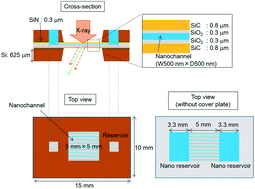Nano X-ray diffractometry device for nanofluidics
Abstract
Nanofluidics is gaining attention because it has unique liquid and fluidic properties that are not observed in microfluidics. It has been reported that many liquid properties change when the size of a fluidic channel is reduced below 500–800 nm. To discuss the underlying mechanism, information on the microscopic liquid structure must be obtained (e.g., by X-ray diffractometry). However, the very small volume (attoliters to femtoliters) of a nanochannel and the large volume of its glass substrate prevent measurement of signals from the nanochannel liquid. In this study, we report a novel nanofluidic device that can be used in conjunction with X-ray diffractometry to analyze the structure of water confined in nanochannels. Top-down and bottom-up micro- and nano-fabrication processes were established, and the substrate thickness of the measurement area was reduced to only 2.7 μm, which was almost 1000 times smaller than that of conventional substrates (millimeter scale). With this new device, X-ray diffraction signals were clearly observed in nanochannels 500 nm wide and deep. Based on the X-ray diffraction pattern, the radial distribution function was calculated, which showed a structure nearly similar to that of a bulk sample. Therefore, X-ray diffractometry in nanochannels was realized. This method will provide important information on how a liquid behaves when confined in a nanospace and contribute to chemistry and biology on scales of 10–100 nm (e.g., inter- and intra-cellular spaces). It is also important for designing chemical reactions and fluidic circuits in nanochannels for realizing highly functional devices.



 Please wait while we load your content...
Please wait while we load your content...